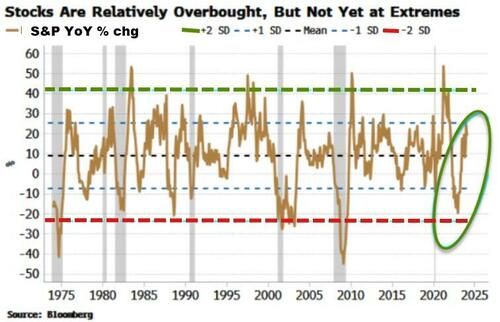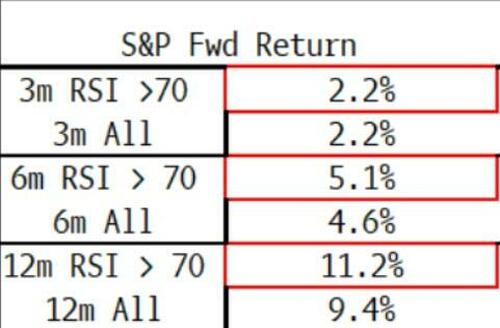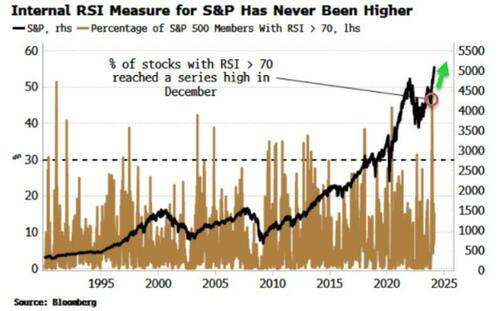Overbought Stock Markets Often Become Even More Overbought
Authored by Simon White, Bloomberg macro strategist,
When stock indices display signs of overboughtness, they typically go on to outperform. The S&P 500 and Nasdaq are overbought today, but there is little historically to prevent them from becoming more overbought before reversing.
Market tops and market bottoms are different: the first is a process, while the second is typically an event that happens with more suddenness. The fact that market tops last a long time – often months – means they often display persistent signs of being stretched to the upside. That means overbought markets can go on to become more overbought, before finally capitulating.
The S&P today is displaying signs of overboughtness. Annual returns in the index are mean reverting. The market recently reached its one-standard deviation line, but as the chart below shows it can become more overbought still. That’s especially the case when the market is bouncing from very oversold conditions, which the S&P 500 was in late 2022.
The S&P’s 14-day RSI is also trading just below 70 (above 70 and the market is generally considered to be overbought).
If we look at the average forward returns in the index for all the times when the RSI is more than 70 (going back to 1970), we can see the 3-month return is about the same as the whole-sample average, while the six and 12-month returns are above their average.
Overboughtness not being an impediment to further gains can be seen even more clearly if we look at RSI internals, i.e. the percentage of S&P 500 stocks whose RSI is more than 70. This measure reached a series high at the end of last year, yet as we now know this did not lead to a selloff. Instead the market surged higher.
And at the same time, the market has become less overbought on this measure, with the percentage of stocks back down to 15.
When the market is overbought on the RSI internals measure (using 30 as a threshold, i.e. whenever more than 30% of stocks’ RSI is more than 70), it slightly underperforms on a three-month basis, is about even on a six-month basis, but outperforms on a 12-month horizon.
It’s a similar story choosing another measure of overboughtness – the percentage of stocks in the S&P trading above their 200-day moving average. Using 70% as a threshold here, the market goes on to outperform on a three, six and 12 month basis.
Tyler Durden
Wed, 02/28/2024 – 14:05
via ZeroHedge News https://ift.tt/s0Xu3yB Tyler Durden


